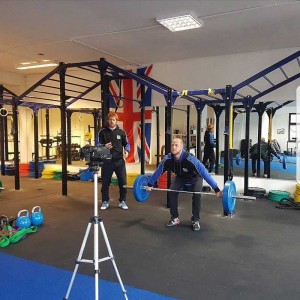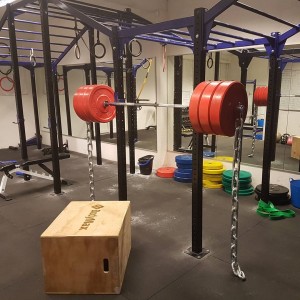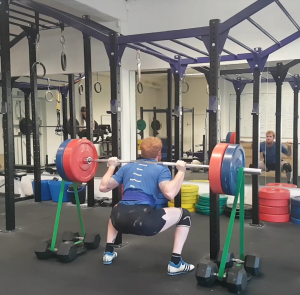What is strength & power?
Strength is most commonly defined as the highest amount of “force” that can be exerted by the muscles of the body to overcome the most resistance in a single effort.
The terms explosive strength and power are used to describe the ability to overcome a resistance with a fast contraction. There are slight differences between these two terms. However, they both relate to producing force in minimal time.
Meanwhile the terms muscular and strength endurance are used to describe the ability to express force many times over.
It’s key to remember that just because someone can produce huge amounts of force, it does not necessarily mean they can effectively use this force explosively.
This brings me to the paradox linking muscle force and speed (velocity). Force creates faster movement. However, the corresponding tension restricts speed. Therefore, (using a boxer as an example) during a strike, not only is it essential that fighters can contract their muscles creating maximal force, they need the ability to facilitate a relaxation phase allowing for maximal speed.
The relaxation phase is then followed by a secondary maximal contraction (just before the strike lands), that again creates total body tension, essentially putting a fighter’s whole bodyweight behind the strike – the initial and secondary contraction is referred to as the “double pulse”.
When it comes to performance, it’s not just about “rate of muscle contraction”, it’s also about “rate of relaxation” – Strength (Force) x Speed (Velocity) = Power!
One final aspect of strength which is often overlooked, is the fact strength also refers to the robustness of the interconnected systems that make up your structure. Your skeletal system and soft tissues, specifically muscles, tendons and ligaments. Without the ability of your structures to accommodate the load or stresses placed on them, there can be no progression.
How do we develop Strength & Power?
Any form of movement/exercise will strengthen your structure to some extent, especially if you do very little in the first place. However, it comes down to what is optimal.
The most common methods of strength development are working at maximal or near maximal loads for low rep ranges. However, less well known is the “dynamic effort method” (lifting weights at speed), which teaches your nervous system/muscles to fire quickly, which generates more power than moving a heavy weight slowly.
These are methods described in “Science and Practice of Strength Training” by Vladimir M. Zatsiorsky, a book I highly recommend.
· The Maximal Effort Method – Most you can lift – 90%+ of 1RM.
· Submaximal Effort Method – Submaximal weight for submaximal reps – 75-90% of 1RM.
· Repeated Effort Method – Submaximal weight for maximal reps.
· Dynamic Effort Method – Maximal speed – 50-60% of 1RM.
Essentially you want to lift heavy loads as this will elicit the most strength gains. However, you also want to lift submaximal loads with maximum speed to again elicit strength gains, but more specifically “rate of force development”, which is a measure of how fast you can develop force – the ability to produce force quickly is the epitome of athletic prowess!
Adding Accommodating Resistance to Increase Rate of Force Development
Accommodating resistance involves using specialist means (bands and chains) to accommodate resistance throughout the full range of motion.
· Chains work by deloading onto the floor at the bottom and raising off the floor as you progress through the lift.
· Bands work by stretching as you progress through the lift, increasing the band tension.
During a lift such as a squat, deadlift or bench press, leverage is limited at the bottom of the movement and greatly increases as you progress through the lift. Therefore, when a lift is performed without accommodating resistance, you must work hard to initially raise the barbell. However, as your leverage improves, you don’t need to produce as much force and must decelerate to control the barbell.
When accommodating resistance is used, the weight increases as you progress through the lift. So, as your leverage increases, so does the load. Therefore, you must continually accelerate to complete the lift.
Essentially, accommodating resistance allows you to maximise rate force development. I recommend its use during various methods of strength development (maximal and dynamic effort methods). However, I most commonly prescribe it to Dynamic Effort sets.
Compensatory Acceleration & Mind Muscle Connection
A key concept which I teach to my athletes that helps to increase overall strength and power development is “compensatory acceleration”. This is a great method to use when accommodating resistance is not present and therefore, not pushing you to keep producing maximal force.
Compensatory acceleration simply involves making a conscious effort to maximize force and speed throughout the full range of motion, specifically as leverage improves. Often when individuals lift a heavy load, they grind out of the bottom (producing maximal force). However, as leverage improves, they make no effort to keep accelerating and often coax through the rest of the lift.
Some may argue that speeding up as the lift progresses happens naturally, but I guarantee that most are not making a conscious effort on every rep of every set to maximize this. Obviously, you must ensure you decelerate at the top of the lift to ensure the barbell does not fly out of your hands, or off your back. But there is still a good portion of most lifts where individuals could promote greater rate of force development, and in turn greater progressions.
I often say that compensatory acceleration is to sports athletes, what mind muscle connection is to bodybuilders.
Mind muscle connection involves making a conscious effort to think about the muscle being worked to help increase its engagement and ultimately stimulate further muscular development. Essentially, both these methods will help you to maximize the effects of your training.
Train like an Athlete!
Thanks for reading
Jay
Follow us on:
Facebook: www.facebook.com/5sfitnessuk
Twitter: www.twitter.com/5sfitness
Instagram: www.instagram.com/5s_fitness
YouTube: www.youtube.com/channel/UC66XVf9NZBO8j-V4or5d2Tg



